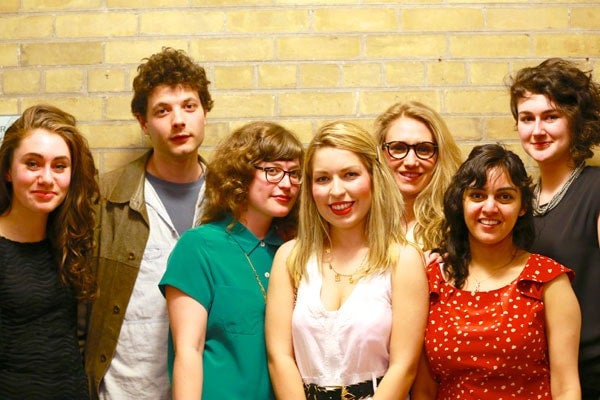
The 2013 Hart House Review
Published: April 23, 2013
Founded in 1992, the Hart House Review is a showcase for aspiring visual artists and writers, featuring poetry, prose, art and photography.
The annual, student-produced journal ensures at least 70% of its content comes from University of Toronto contributors. Some of Canada's best-known authors – Rohinton Mistry, Camilla Gibb and Lynn Crosbie – were published in the review while they were U of T students. And scores of Canada's publishing professionals got their first taste of the business working on the publication.
U of T News spoke with this year's editor-in-chief, Tracy Kyncl, about putting together this year's Hart House Review.
What is it like to be working on such a well-known literary review?
It's both thrilling and intimidating. I felt that I had a really huge responsibility to ensure a certain level of quality and at the very beginning of the process - being new to publishing – I was a little worried. But as I gathered the staff together and we started to brainstorm then I realized we had every creative resource available to us. Once we got the submissions in, then I knew there was nothing to worry about because the work was so beautiful. So by the end of it, the intimidation turned into joy and pride at being part of something so special.
The staff has an incredible amount of respect for our predecessors and I think that it motivated us to make sure we do it right. On the one hand you could be intimidated, but on the other hand I think the staff and I relish the possibility of the HHR launching another U of T student's career and I think it will be a joyous occasion to hear the familiar names in other publications and news outlets in the future as these talented people get all the recognition they deserve.
What were some of the challenges for this year's review?
One of the more challenging aspects of the Review this year was doubling the staff and managing a large amount of people. Everyone was really organized and helpful but there were a few moments during crunch time when my head was spinning and I was thinking – is this done? Is that done? And of course, the biggest problem of all is budgeting. Hart House is always really generous with the amount of funding they give to student publications, however, printing, advertising, and other costs are high and when you want to put out a really incredible product it's hard to work within strict budget limits. I think finance was probably the most difficult part.
And the best part?
I am not sure if I can narrow it down to one aspect but there are a few highlights to be sure. Since I doubled the staff, that enabled everyone to focus on specific tasks and not be too overwhelmed with work. Seeing people really come into their own, embrace challenges, and seeing students behave and manage work in a very professional manner was certainly inspiring.
Reading and selecting the submissions is also a favourite part of mine and I think most of the staff really likes that part. It's humbling to be a part of people's creative adventures. It takes a lot of courage to go share your work with strangers as a writer or artist, and especially strangers who you want to "approve" your work. I was on the editorial board last year and seeing the creativity and talent of U of T was what really inspired and motivated me to want to continue working on the Review.
Lastly – layout was so much fun. We really wanted to be different from other and past publications. That's why we stayed away from photography and illustration. We wanted something textural and experiential and for the Review to embody the artistic pulse of the University.
Will you and your colleagues pursue a career in publishing?
When I was interviewing for staff positions, a large number of the staff mentioned that they really want to pursue publishing, writing, layout design, and fine arts. I think that's one of the reasons why the Review turned out so well this year. We (myself included) really treated it like a job, not an extra-curricular activity. I would love to pursue publishing. I know it's a hard industry to get into, however, I am glad we all had this experience to prepare us for future challenges and to give us a good idea of all the aspects that go into making a magazine.
What did you learn from this experience?
I learned so much it's hard to know where to begin. Sarah Malik, the managing editor, taught me a lot about how to be an effective leader. She encouraged me to be firm and to think about replies and strategies before I jumped in. I am an enthusiastic person and this process taught me to take a moment to consider a situation before reacting immediately.
I also learned that at times you can't please everyone and when you're in my position as editor-in-chief it's important to stay true to the philosophy that whatever is best for the magazine is the best thing to do. I also learned that you can't get discouraged when things get a little hairy. I had a vision in my mind from the get-go that the magazine would be fresh, exciting, innovative and at the end of the year the party would be big, bold, and full of happy people. The process was challenging but looking back on it now I feel good that I stuck to my vision, saw it through, and my expectations were certainly exceeded.
The Hart House Review is available at retailers across Canada. (See the complete list.)



